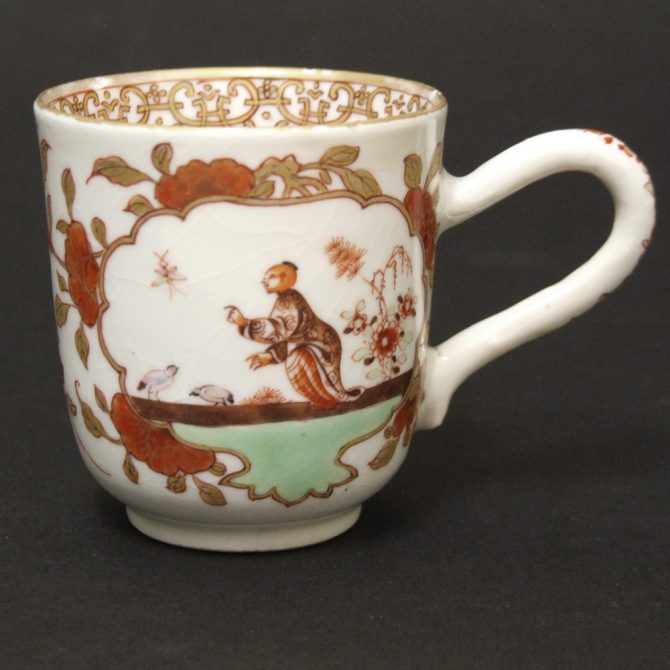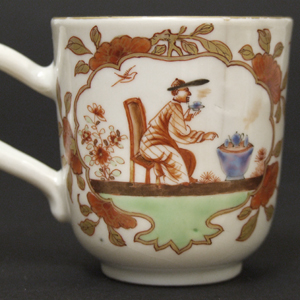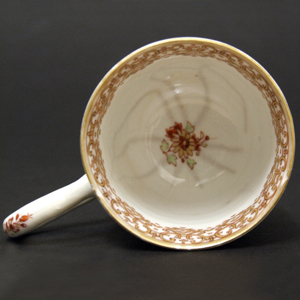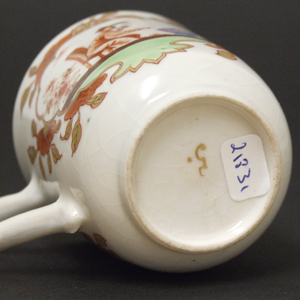
QIANLONG 1736 – 1795 Chinese Soft-Paste Porcelain
An Unusual 18th Century Chinese Export Soft-Paste Porcelain Coffee Cup in the Meissen Style, Qianlong Period c.1750. The Scenes After Designs of c.1720 – 1730 by J.G.Horoldt are of a Chinese Man Kneeling Down Next to Two Birds and Another Chinese Man Drinking Tea in a Garden. The Base with a Psuedo Meissen Workman`s Mark `5`.
SOLD
- Condition
- One large crack c.28 mm and some crazing to the glaze on the interior.
- Size
- Height : 6.2 cm (2 1/3 inches)
- Provenance
- N/A
- Stock number
- 21831
- References
- For Information about Chinese Soft-paste Porcelain See : Chinese Porcelain in the Collection of the Rijksmuseum Amsterdam, The Ming and Qing Dynasties (Christiaan Jorg, Phillip Wilson, The Rijksmuseum, 1997) Page 117 Item 119.
Information
This Chinese Porcelain cup is decorated in the Chinoiserie style of Meissen artist Johanne Gregorius Horoldt (1696-1775). In other words it is a Chinese copy of a German interpretation of the Chinese style. Horoldt`s designs were never copies of Chinese porcelain itself, rather they were whimsical fantasy, an inventive exoticism, they were true Chinoiserie. What is even stranger is the type of porcelain used to made this copy of Meissen. The German factory of Meissen was renowned as the inventor of true, hard-paste porcelain in Europe but the Chinese have chosen to make their copy in soft-paste porcelain. This was a more expensive option for the Chinese, but maybe they thought that the Meissen paste was not as `true` as their own hard-paste porcelain and that it was closer to their soft-paste porcelain.
Chinese Copies of Meissen :
The Chinese export porcelain trade was directly threatened by the new European porcelain factories opening up during the 18th century, often under royal patronage these factories catered for a seemingly never ending demand for porcelain. They copied the fashionable styles of the exotic Oriental imports, but at the same time the Chinese had their eye firmly on what sold in Europe. The most common Chinese copies of Meissen were the designs of Harbour Scenes (see stock numbers 21663 and 21497 in our sold items) but other designs were copied too. Curiously the much less common Chinese copies of blue and white Meissen porcelain are in soft-paste porcelain where as most of the copies of coloured Meissen porcelain are hard-paste.
Chinese Soft-Paste Porcelain :
Christiaan Jorg States in : Chinese Porcelain in the Collection of the Rijksmuseum Amsterdam, The Ming and Qing Dynasties (Christiaan Jorg, Phillip Wilson, The Rijksmuseum, 1997) "Chinese soft-pate porcelain, which is different from European soft-paste, originated about 1700 and became popular in the second quarter of the 18th century as part of the export assortment. Unlike ordinary porcelain, it is not translucent and often has a creamy-white appearance. The glaze is often finely crackled as a result of a difference in cooling between the glaze and the body. The later is made of a white-firing clay, called huashi, `slippery stone`, the use of which is documented in the reports of 1712 and 1722 by the Jesuit Pere d`Entrecolles. As the clay was expensive, soft-paste pieces are usually small and thinly potted. They are also well-painted, as the body is particularly suitable for detailed drawing. Besides this `true` soft-paste, there are pieces with an ordinary porcelain body and a coating of `huashi` clay, which gives the same effect". Chinese soft-paste porcelain of the early 18th century appears to be confined to small objects used by Chinese scholars, small vases for a single flower, seal-paste boxes and other objects for the scholar`s desk. These pieces were special and more expensive than their hard-paste porcelain counterparts. By the mid-18th century soft-paste porcelain was used to a limited degree for export-ware, and few if any scholar`s objects were produced. It was used for, among other designs, pieces in the Meissen style but only for the blue and white porcelain. It seams curious to be copying European hard-paste porcelain with Chinese soft-paste porcelain, especially as it was more expensive to produce. This is especially odd as all the coloured Meissen porcelain was copied in hard-paste porcelain. Ironically many of the Meissen designs copied were themselves copies of Chinese designs. During the latter part of the 18th century soft-paste porcelain was used for larger pieces, vases, jars and other export wares, but even at this time it was normally reserved for the better quality painting and was painted with a good bright cobalt pigment.


